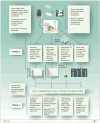Designing phase 0 cancer clinical trials
- PMID: 18559582
- PMCID: PMC2435428
- DOI: 10.1158/1078-0432.CCR-07-4560
Designing phase 0 cancer clinical trials
Abstract
Phase 0 trials are designed primarily to evaluate the pharmacodynamic and/or pharmacokinetic properties of selected investigational agents before initiating more traditional phase I testing. One of the major objectives of phase 0 trials is to interrogate and refine a target or biomarker assay for drug effect in human samples implementing procedures developed and validated in preclinical models. Thus, close collaboration between laboratory scientists and clinical investigators is essential to the design and conduct of phase 0 trials. Given the relatively small number of patients and tissue samples, showing a significant drug effect in phase 0 trials requires precise and reproducible assay procedures and innovative statistical methodology. Furthermore, phase 0 trials involving limited exposure of a study agent administered at low doses and/or for a short period allow them to be initiated under the Food and Drug Administration exploratory investigational new drug guidance with less preclinical toxicity data than usually required for traditional first-in-human studies. Because of the very limited drug exposure, phase 0 trials offer no chance of therapeutic benefit, which can impede patient enrollment, particularly if invasive tumor biopsies are required. The challenges to accrual are not insurmountable, however, and well-designed and executed phase 0 trials are feasible and have great potential for improving the efficiency and success of subsequent trials, particularly those evaluating molecularly targeted agents.
Figures
References
-
- Kola I, Landis J. Can the pharmaceutical industry reduce attrition rates? Nature Reviews Drug Discovery. 2004;3:711. - PubMed
-
- Kummar S, Kinders R, Rubinstein L, et al. Compressing drug development timelines in oncology using phase ‘0’ trials. Nat Rev Cancer. 2007;7:131–9. - PubMed
-
- Jacobson-Kram D, Mills G. Leveraging Exploratory INDs to Speed Drug Development. Clin Cancer Res. 2008:14. in press. - PubMed
-
- Kinders R, Parchment RE, Ji J, et al. Phase 0 Clinical Trials in Cancer Drug Development: From FDA Guidance to Clinical Practice. Mol Interv. 2007;7:325–34. - PubMed
Publication types
MeSH terms
Grants and funding
LinkOut - more resources
Full Text Sources
Medical




